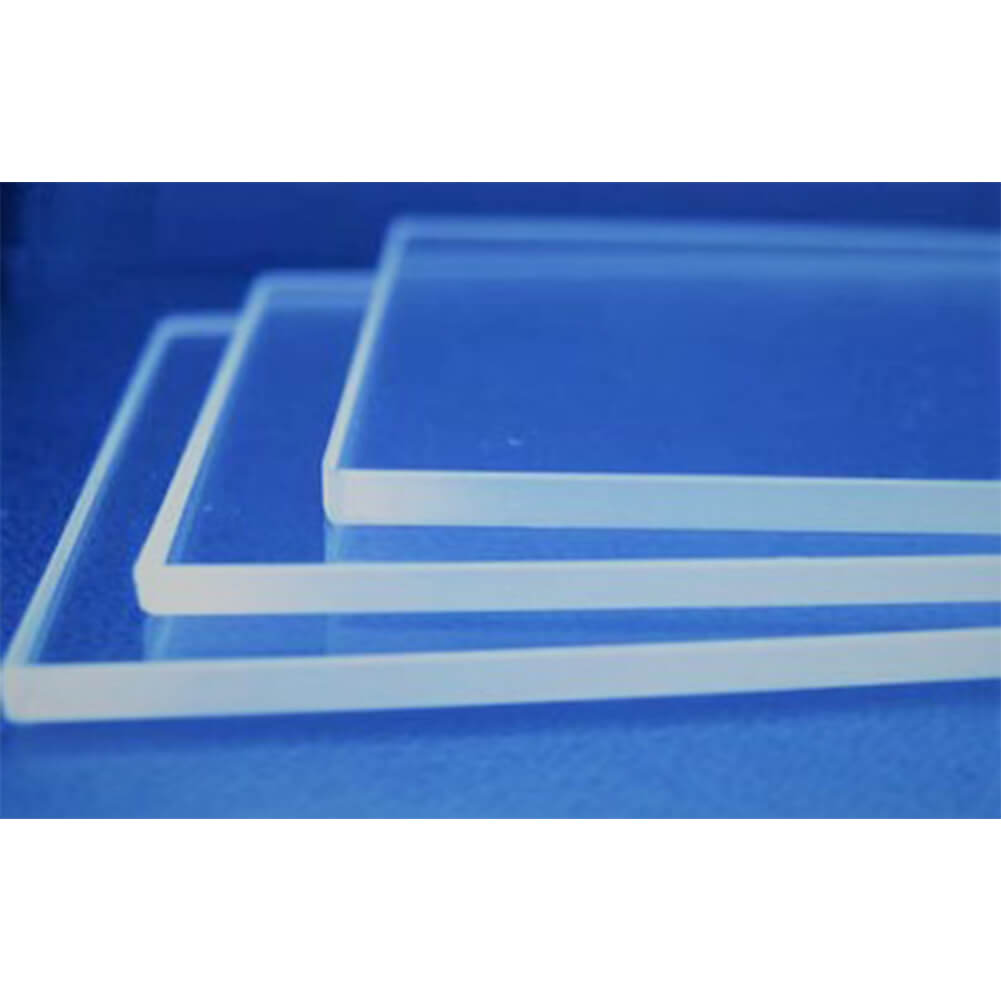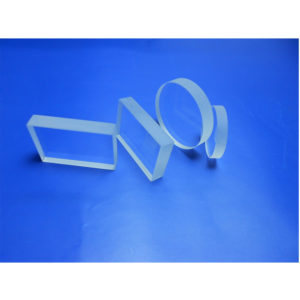Fused Silica
Fused Silica is formed by chemical combination of silicon and oxygen. Fused Silica is perfect optical material due to its good UV and IR transmission, low coefficient of thermal expansion. It has high stability and resistance to thermal shock over large temperature excursions, wide temperature operating range and high laser damage threshold.
There are different types Fused Silica according the different application. In China, there are mainly three types, ie. JGS1, JGS2, JGS3. Below are the application and their equivalent to other Fused Silica supplier.
JGS1: equivalent to Suprasil 1 and 2 (Heraeus), Spectrosil A and B (Saint-Gobain) and Coming 7940 (Coming), Dynasil 1100 and 4100 (Dynasil). JGS1 is transparent in the ultraviolet and visible regions, and has no absorption hands in 170-250 nm wavelength intervals. It has intensive OH absorption band in the
interval of wavelength 2600-2800 nm. JGS1 is used for optics operating in the deep UV and the visible wavelength range (Laser Lenses, Windows, Prisms, Mirrors, etc.). It is practically free of bubbles and inclusions.
JGS2: equivalent to Homosil 1,2 & 3 (Heraeus), Dynasil 1000 & 4000 and 5000 & 6000 (Dynasil)
JGS2 provides good UV and visible transmission.It is close in physical and chemica properties to JGS1. Available in thin & small sheet pieces, JGS2 is virtually bubblefree. Elements built from large pieces vill most likely contain bubbles, so application should not be sensitive to these inclusions. Ideal Applications for JGS2: Condenser optics not concerned with scatter or distortion, high temperature and pressure applications, optical flats, microscope slides and sight glasses.
JGS3: equivalent to Suprasil 300 (Heraeus).
JGS3 is transparent in the ultraviolet, visible and infrared spectral regions, without considerable absorption bands in the 185-250 nm spectral region. It has no absorption bands in the visible physical properies with outstanding optical characteristics in the deep UV and the IR wavelength range. It is those requiring very wide wavelength range from DUV to MIR. It is quite a bit more expensive than Silicon and slightly less expensive than Calcium Fluoride or ZnS Multi-spectral grade.
| Material Specification: | ||
| Parameter|Value | UV grade Fused Silica | |
| Maximum Size | <Φ400mm | |
| Transmission Range | 0.17~2.10um | |
| (Medium transmission ratio) | (Tavg>90%) | |
| OH- Content | 1200 ppm | |
| Fluorescence (ex 254nm) | Virtually Free | |
| Impurity Content | 5 ppm | |
| Birefringence Constant | 2-4 nm/cm | |
| Melting Method | Synthetic CVD | |
| Applications | Laser substrate: Window, lens, prism, mirror | |
| Material Specification: | ||
| Parameter|Value | UV grade Fused Silica | |
| Maximum Size | <Φ400mm | |
| Transmission Range | 0.17~2.10um | |
| (Medium transmission ratio) | (Tavg>90%) | |
| OH- Content | 1200 ppm | |
| Fluorescence (ex 254nm) | Virtually Free | |
| Impurity Content | 5 ppm | |
| Birefringence Constant | 2-4 nm/cm | |
| Melting Method | Synthetic CVD | |
| Applications | Laser substrate: Window, lens, prism, mirror… | |
| Hardness | 5.5 – 6.5 Mohs’ Scale 570 KHN 100 | |
| Transmission Range | 0.17~2.10um |
| (Medium transmission ratio) | (Tavg>90%) |
| OH- Content | 1200 ppm |
| Fluorescence (ex 254nm) | Virtually Free |
| Impurity Content | 5 ppm |
| Birefringence Constant | 2-4 nm/cm |
| Melting Method | Synthetic CVD |
| Applications | Laser substrate: Window, lens, prism, mirror… |
| Hardness | 5.5 – 6.5 Mohs’ Scale 570 KHN 100 |
| Design Tensile Strength | 4.8×107 Pa (N/mm2) (7000 psi) |
| Design Compressive Strength | Greater than 1.1×109 Pa (160,000 psi) |
| Bulk Modulus | 3.7×1010 Pa (5.3×106 psi) |
| Rigidity Modulus | 3.1×1010 Pa (4.5×106 psi) |
| Young’s Modulus | 7.2×10-10 Pa (10.5×106 psi) |
| Poisson’s Ratio | 0.17 |
| Coefficient of Thermal Expansion | 5.5×10-7cm/cm.°C (20°C-320°C) |
| Thermal Conductivity | 1.4 W/m.°C |
| Specific Heat | 670 J/kg.°C |
| Softening Point | 1683°C |
| Annealing Point | 1215°C |
| Strain Point | 1120°C |
| Electrical Receptivity | 7×107 ohm.cm (350°C) |
| Dielectric Properties (20°C and 1 MHz) | |
| Constant | 3.75 |
| Strength | 5×107 V/m |
| Loss Factor | Less than 4×10-4 |
| Dissipation Factor | Less than 1×10-4 |
| Velocity of Sound-Shear Wave | 3.75×103 m/s |
| Velocity of Sound/Compression Wave | 5.90×103 m/s |
| Sonic Attenuation | Less than 11 db/m MHz |
| Permeability Constants (cm3mm/cm2 sec cm of Hg) | (700°C) |
| Helium | 210×10-10 |
| Hydrogen | 21×10-10 |
| Deuterium | 17×10-10 |
| Neon | 9.5×10-17 |
| Chemical Stability (except hydrofluoric) | High resistance to water and acids |







